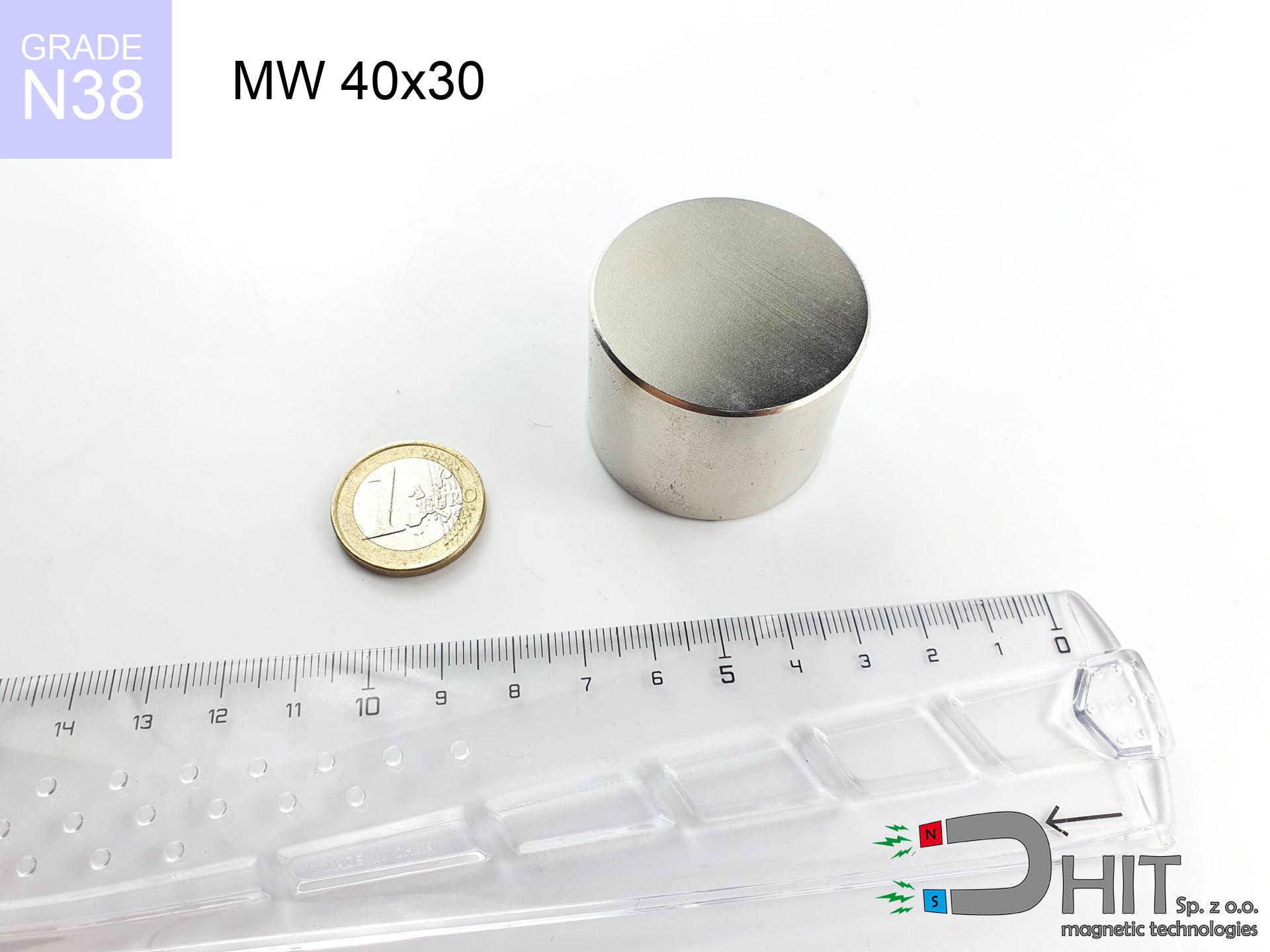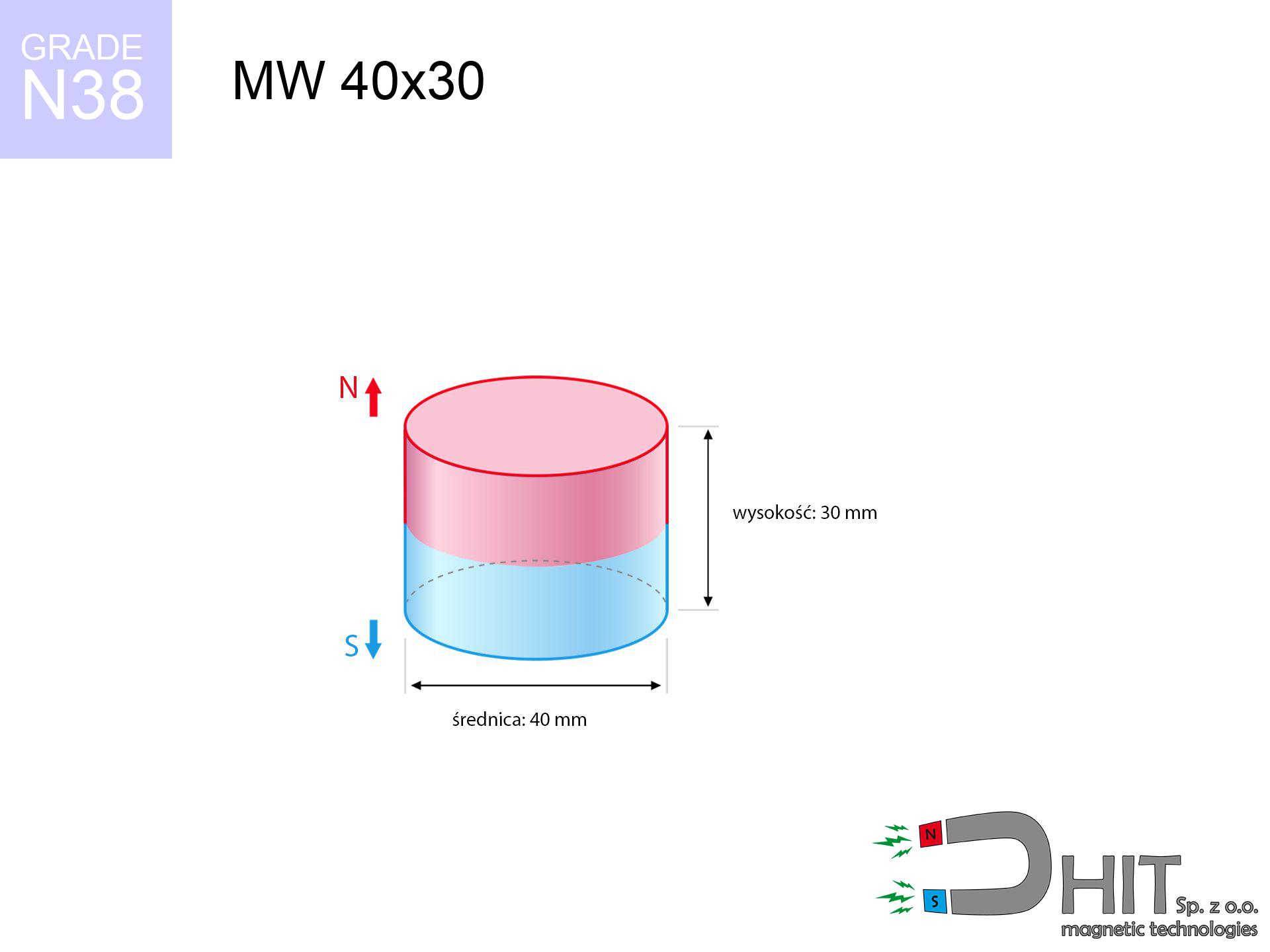MW 40x30 / N38 - neodymium magnet
cylindrical magnet
catalog number 010068
GTIN: 5906301810674
diameter Ø
40
mm [±0,1 mm]
height
30
mm [±0,1 mm]
magnetizing direction
→ diametrical
capacity ~
66.35 kg / 650.67 N
magnetic induction ~
515.71 mT / 5,157 Gs
max. temperature
≤ 80
°C
catalog number 010068
GTIN: 5906301810674
diameter Ø
40 mm [±0,1 mm]
height
30 mm [±0,1 mm]
magnetizing direction
→ diametrical
capacity ~
66.35 kg / 650.67 N
magnetic induction ~
515.71 mT / 5,157 Gs
max. temperature
≤ 80 °C
104.80 ZŁ gross price (including VAT) / pcs +
85.20 ZŁ net price + 23% VAT / pcs
bulk discounts:
need more quantity?Do you have trouble in choosing?
Call us tel: +48 22 499 98 98 or get in touch through contact form on the contact page. You can check the mass and the appearance of neodymium magnets in our magnetic mass calculator force calculator
Orders placed by 2:00 PM will be shipped on the same business day.
Specification: cylindrical magnet 40x30 / N38 → diametrical
Magnetic properties of the material N38
Physical properties of sintered neodymium magnets Nd2Fe14B
Moreover, even though neodymium is a component of the strongest magnets, they are prone to corrosion in humid environments. Therefore, they are coated with a thin layer of epoxy to protect them from corrosion. It's worth noting that NdFeB neodymium magnets are about 13% lighter than SmCo magnets and, despite their power, are brittle, which requires special caution during their handling. Therefore, any mechanical processing should be done before they are magnetized.
In terms of safety, there are several recommendations regarding the use of these magnets. They should not be used in acidic, basic, organic environments or where solvents are present, and also in water or oil. Furthermore, they can distort data on magnetic cards and hard drives, although data deletion using a neodymium magnet is not always certain.
In terms of properties in different environments, neodymium magnets are susceptible to corrosion, especially in conditions of high humidity. Therefore, they are often coated with coatings, such as nickel, to preserve them from external factors and extend their lifespan. Temperatures exceeding 130°C can result in a reduction of their magnetic strength, although there are particular types of neodymium magnets that can withstand temperatures up to 230°C.
As for risks, it is important to avoid using neodymium magnets in acidic environments, basic environments, organic or solvent environments, unless they are properly protected. Additionally, their use is not recommended in wet conditions, oil, or in an atmosphere containing hydrogen, as they may lose their magnetic properties.
Shopping tips
Advantages as well as disadvantages of neodymium magnets NdFeB.
In addition to immense power, neodymium magnets have the following advantages:
- They do not lose their power (of the magnet). After about 10 years, their power decreases by only ~1% (theoretically),
- They are exceptionally resistant to demagnetization caused by an external magnetic field,
- By applying a shiny coating of nickel, gold, or silver, the element gains an aesthetic appearance,
- They have exceptionally high magnetic induction on the surface of the magnet,
- By using an appropriate combination of materials, they can achieve significant thermal resistance, allowing them to operate at temperatures up to 230°C and above...
- Thanks to the flexibility in shaping or the ability to adapt to specific requirements – neodymium magnets can be produced in many variants of shapes or sizes, which expands the range of their possible uses.
- Wide application in modern technologies – are used in hard drives, electric drive mechanisms, medical equipment and very advanced devices.
Disadvantages of neodymium magnets:
- They can break as they are fragile when subjected to a powerful impact. If the magnets are exposed to impacts, it is suggested using magnets in a steel housing. The steel housing in the form of a holder protects the magnet from impacts and also increases its overall strength,
- They lose strength at high temperatures. Most neodymium magnets experience permanent loss of strength when heated above 80°C (depending on the shape and height). However, we also offer special magnets with high temperature resistance, up to 230°C,
- Due to their susceptibility to corrosion in a humid environment, we recommend using waterproof magnets made of rubber, plastic, or other moisture-resistant materials when using them outdoors,
- The use of a cover or a magnetic holder is recommended due to the limited possibilities of manufacturing threads or complex shapes in the magnet
- Potential hazard associated with microscopic parts of magnets pose a threat, when accidentally ingested, which becomes significant in the context of children's health. Furthermore, tiny parts of these devices can hinder the diagnostic process when they are in the body.
Precautions
Keep neodymium magnets far from youngest children.
Neodymium magnets are not toys. You cannot allow them to become toys for children. In the case of small magnets, they can be swallowed and cause choking. In such cases, the only solution is to undergo surgery to remove the magnets, and otherwise, it can even lead to death.
Neodymium magnets can demagnetize at high temperatures.
Despite the general resilience of magnets, their ability to retain their magnetic strength can be influenced by factors like the type of material used, the magnet's shape, and the intended purpose for which it is employed.
Neodymium magnets are highly susceptible to damage, resulting in shattering.
In the event of a collision between two neodymium magnets, it can result in them getting chipped. Despite being made of metal and coated with a shiny nickel plating, they are not as hard as steel. At the moment of connection between the magnets, tiny sharp metal pieces can be propelled in various directions at high speed. Eye protection is recommended.
Keep neodymium magnets as far away as possible from GPS and smartphones.
Neodymium magnets generate intense magnetic fields that interfere with magnetometers and compasses used in navigation, as well as internal compasses of smartphones and GPS devices.
Neodymium magnets can attract to each other, pinch the skin, and cause significant swellings.
In the case of placing a finger in the path of a neodymium magnet, in such a case, a cut or even a fracture may occur.
Dust and powder from neodymium magnets are highly flammable.
Do not attempt to drill into neodymium magnets. Mechanical processing is also not recommended. If the magnet is crushed into fine powder or dust, it becomes highly flammable.
Neodymium magnets are the most powerful magnets ever invented. Their power can surprise you.
Make sure to review all the information we have provided. This will help you avoid harm to your body and damage to the magnets.
The magnet is coated with nickel. Therefore, exercise caution if you have an allergy.
Studies show a small percentage of people have allergies to certain metals, including nickel. An allergic reaction often manifests as skin redness and rash. If you have a nickel allergy, try wearing gloves or avoid direct contact with nickel-plated neodymium magnets.
People with pacemakers are advised to avoid neodymium magnets.
Neodymium magnets produce strong magnetic fields that can interfere with the operation of a heart pacemaker. Even if the magnetic field does not affect the device, it can damage its components or deactivate the entire device.
Keep neodymium magnets away from TV, wallet, and computer HDD.
Strong magnetic fields emitted by neodymium magnets can damage magnetic storage media such as floppy disks, credit cards, magnetic ID cards, cassette tapes, video tapes, or other devices. They can also damage televisions, VCRs, computer monitors, and CRT displays. You should especially avoid placing neodymium magnets near electronic devices.
To illustrate why neodymium magnets are so dangerous, see the article - How dangerous are powerful neodymium magnets?.




![magnetic separator 18x125 [2xM5] / N42 magnetic separator 18x125 [2xM5] / N42](https://cdn3.dhit.pl/graphics/products/sm-18x125-2xm5-cij.jpg)
![magnetic separator 25x100 [2xM8] / N52 magnetic separator 25x100 [2xM8] / N52](https://cdn3.dhit.pl/graphics/products/sm-25x100-2xm8-fin.jpg)

![magnetic separator 32x250 [2xM8] / N52 magnetic separator 32x250 [2xM8] / N52](https://cdn3.dhit.pl/graphics/products/sm-32x250-2xm8-guf.jpg)

